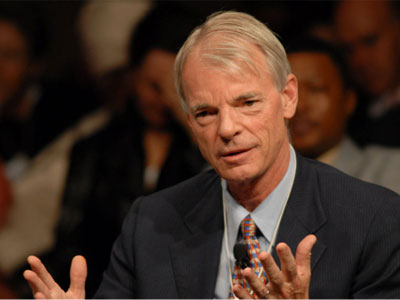 2001年诺贝尔经济学奖获得者迈克尔-斯宾塞今日为新浪财经独家撰文表示,经济危机后,投资者需要在投资策略时考虑到系统性风险的可能性。
2001年诺贝尔经济学奖获得者迈克尔-斯宾塞今日为新浪财经独家撰文表示,经济危机后,投资者需要在投资策略时考虑到系统性风险的可能性。
导读:2001年诺贝尔经济学奖获得者迈克尔-斯宾塞今日为新浪财经独家撰文表示,经济危机后,投资者需要在投资策略时考虑到系统性风险的可能性。中短期的经营收益不应该被视为长期投资回报的精确信号。
以下是文章全文:
投资人已经在目前的经济危机受到重创,他们正在吸取经验教训和进行投资战略的调整。
在我看来,给投资人最核心的教训是:不是所有的风险组成都是静态的,而是演变成各种尚未充分理解的方式,且政府的监管并不能完全解决这些问题。出于这个原因,市场的自我调整能力应该发挥作用,这需要在投资策略考虑到系统性风险的可能性。
一个整体的系统性威胁可能出现的方式是难以检测的,当然,重大的系统性中断不会每年都发生。相反,不稳定性逐渐积聚,直到系统受到震撼和重置,而这种强烈的震撼和重置的具体时间是无法预测的。这意味着正待解决的系统性风险,比起那些为投资者更为关注的非系统性的、固定投入的风险,对它的解决需要更长的时间。
我们来考虑一个10年期投资,假设有9年的“正常”的平均回报,紧接着一个由系统性风险所造成的“糟糕”的一年。在这种情况下,作为一个例子,如果在正常情况下一个投资策略每年的回报率为8%,在第十年的时候产生一个20%这样大的震动,就会将平均的每年投资回报率减少3.19个百分点,至4.81%。
会计的系统性风险带来一系列影响。例如,捐赠或养老基金的支付策略将考虑更加长远的、潜在的冲击调整后的平均回报,而不是一个简单的加权平均收益或过去的期末资产价值(现在通常的做法)的平均回报。
当然,你可以认为,危机后的监管改革将最终解决定期的系统性风险问题,我们将回到更舒适的世界,只有相对固定的风险,而不会有定期的不平衡。但是,我不会赌这种情况出现。
目前,毫无疑问,在定期的系统性风险上采取更加保守的做法而产生的竞争和其他后果,在不同机构会有所不同。问题不在于表明只有一个正确的答案,而是投资战略和支出的决定应该考虑到较长期的风险层面。对最终做决策的投资者在确定是否会产生较高的投资回报,和检验震荡后的平均回报是否值得的战略上,这显得更为真实可信。
当投资回报在一个时期内似乎异常的高,并且看起来似乎还在持续,但是会有某样东西,即使我们事先不知道是什么,极有可能将其击落下来。
这一点对大投资者尤其重要,成功的价值投资者可以通过避免投资他们认为被高估资产来降低投资风险。不过,他们也并非无懈可击,因为即使是公平合理的价值投资,或者更确切地说,被低估了的价值投资,都不可避免一场危机或重置资产价格下调的压力后所积聚的系统性风险。
显然,正确的判断是必需的。我的选择是假设冲击相对频繁,但他们的规模和概率有所不同。明智的做法可以规避中级冲击。这也可能有助于减轻较大冲击的影响,并在严重冲击期间来增加净回报潜力(尽管它也可能降低在轻度冲击中获得的回报潜力)。
至少在一个地区,有关流动性管理,许多投资者从危机中吸取了惨痛的教训。问题的重点一直在于现金流的挑战,来自大流动性的投资组合和大规模的系统性冲击,造成了现金流模式的不利变化。
但有两个其他的流动性管理方面的问题值得关注。首先,非流动性投资限制投资者的投资能力:即限制他们调整自己的投资组合以规避在早期预警之后越演越烈的系统性风险。其次,在满目疮痍时候,流动性组合创造投资机会,例如资产价格低迷和投资能力结合起来进行投资,而其他方面则不能或不会产生这样的机会。
这意味着,流动性具有很大的潜在价值,这种价值体现于系统性问题出现时。这个价值应该是“补充”到投资回报率上的,原因是在“正常”时期的各类流动性资产的回报,影响了流动性和非流动性资产的相对吸引力,并且影响各类投资者对资产分配所作出的选择。
所有这一切都突出了对性能和赔偿的新标准的需要,来弥补定期的系统性风险,特别值得注意的是债务和流动资金。低负债,高流动性应该倍受重视来避免现金流困难,确保更大的调整资产分配的灵活性,并创造在经济危机后的机会。
也许最重要的是,当短期和中期的经营收益,特别是在一个时期内收益率非常高的时候,是不应该被视为长期投资回报的精确信号。投资策略不应该依据的假设是所有的时间都是“正常”的时代,而周期性动荡才是不正常的。评估系统性风险和不稳定的投资时间的挑战恰恰就是挑战本身,而不是忽视现象的各种理由。(皎宇 编译于美国洛杉矶)
以下是迈克尔-斯宾塞文章的英文原文。
Investment Strategy after the Crisis
Investors have been hit hard by the current crisis. Lessons are being learned and investment strategies revised.
The central lesson for investors seems to me to be that not all components of risk are static, but rather evolve in ways that are not yet fully understood – and that government regulation cannot fully address. For that reason, the ability of markets to self-correct should play a role as well, which requires that investment strategies attempt to take the possibility of systemic risk into consideration.
Threats to the system as a whole can arise in a manner that is difficult to detect, and that can cause risk-mitigation strategies that work well in normal times to malfunction. Of course, major systemic disruptions do not occur every year. Instead, instability builds up until the system is shocked and resets, with the exact timing unpredictable. This means that addressing systemic risk requires a longer timeframe than that associated with the non-systemic, stationary risks to which investors devote most attention.
Consider a ten-year period and assume that there are nine years of “normal” average returns, followed by a “bad year” caused by the systemic risk component. In that case, as an example, if an investment strategy yields an 8% annual return in normal times, a large shock of 20% at ten year intervals would reduce the average 10 returns by 3.19 percentage points, to 4.81%.
Accounting for systemic risk has several implications. For example, an endowment or pension fund might consider basing its payout decisions more on long-run, potential shock-adjusted average returns than on a simple weighted average of past returns or end-period asset values (the normal practice now).
Of course, you can argue that post-crisis regulatory reform will eventually resolve the problem of periodic systemic risk, and that we will return to the more comfortable world of relatively stationary risk without periodic imbalances. But I would not bet on this happening.
The historical evidence suggests that systemic risk is persistent and resistant to regulatory efforts to eliminate it. Financial innovation will proceed along with regulatory arbitrage. And, while the international dimensions and sources of systemic risk are increasingly important, thus far we have only limited demonstrated capacity, if any, for dealing with them.
There are, no doubt, competitive and other consequences to adopting a more conservative approach that factors in periodic systemic risk, and they will vary across institutions. The point is not to suggest that there is one right answer, but rather that investment strategy and payout decisions should take into account the longer-term dimensions of risk. This is true even for investors who ultimately decide that strategies aimed at generating higher normal and post-shock average returns are worth it.
One can think of periodic systemic risk as an inherent tendency toward reversion to the mean: short- and medium-term returns can deviate considerably and for extended periods from the expected long-run returns associated with various investment strategies and capabilities. Put another way, when returns seem abnormally high for an extended period, they probably are, and something – even if we don’t know in advance what – is likely to bring them down.
This is particularly relevant to large investors who, unlike traders, cannot totally ignore macroeconomic fundamentals without abandoning reasonable diversification. Successful value investors may mitigate risk by shunning what they consider to be overvalued assets. Nevertheless, they are not invulnerable, because even fair valuations – or, indeed, undervaluations – are not exempt from the downward pressures of a crisis or the resetting of asset prices after a build-up of systemic risk.
Clearly, judgment is required. My preference is to assume that shocks arrive relatively frequently, but that they vary in size and probability. A sensible approach could be to hedge against intermediate-level shocks. That might also help mitigate the impact of larger shocks and increase the net return potential during severe shocks (though it might also lower the return potential for more mild shocks).
In at least one area, liquidity management, many investors learned painful lessons from the crisis. The focus has been appropriately on the cash-flow challenges that come from a combination of large illiquid investment portfolios and large systemic shocks that cause adverse shifts in the cash flow models。
But there are two other aspects of liquidity management that deserve attention. First, illiquid investments limit investors' ability to adjust their portfolios in response to early warnings of an increase in systemic risk. Second, in times of widespread distress, liquid portfolios create investment opportunities, as depressed asset prices (often overly so) combine with the capacity to invest while others cannot or will not.
This means that liquidity has potentially significant value, which rises when systemic problems emerge. This value should be “added” to the return that is attributed to various classes of liquid assets in “normal” times, thereby affecting the relative attractiveness of liquid and illiquid assets – and influencing the asset-allocation choices made by various classes of investors.
All of this highlights the need for new benchmarks for performance and compensation that factor in vulnerability to periodic systemic risk, with special attention to debt and liquidity. Low debt and high liquidity should be valued for avoidance of cash-flow distress, ensuring greater flexibility in adjusting asset allocation, and creating opportunities in the aftermath of a crisis.
Perhaps most importantly, short- and medium-run returns, especially during periods when they are high, should not be taken as accurate signals of long-run returns. Investment strategies should not be based on the assumption that all times are “normal” times, and that periodic instability is abnormal. The challenges of assessing systemic risk and the timing of instability are just that – challenges, not reasons to ignore the phenomenon.
(本文作者介绍:2001年诺贝尔经济学奖获得者美国斯坦福大学商学院研究生院前任院长和现任名誉院长,纽约大学斯特恩商学院经济学教授,增长与发展委员会主席。著有《下一次趋同》一书。)
本文为作者独家授权新浪财经使用,请勿转载。所发表言论不代表本站观点。